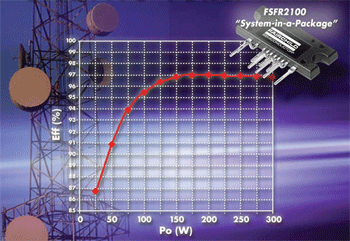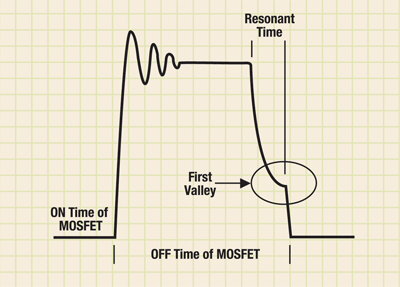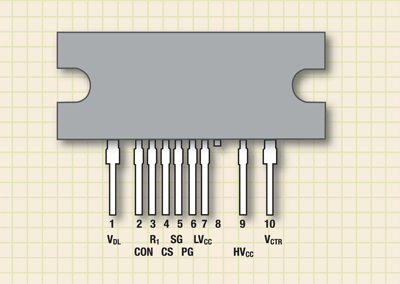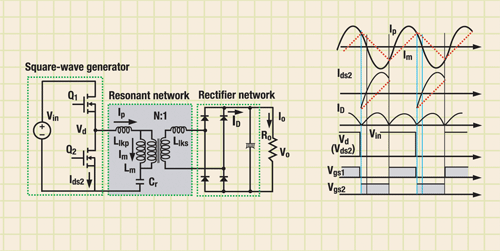The right integrated switch can reduce heat and EMI and also improve power efficiencies 90% or more
BY LUCY A. SNYDER
If you’re designing electronics, it stands to reason that one of your major concerns is power. Side effects of bad power management such as electromagnetic interference, excess heat and inaccurate voltage control can lead to poor device performance or outright failure.
Reliability has always been important to consumers. But more and more environment- and cost-conscious consumers make energy efficiency a primary deciding factor in their electronics purchases.

Ideally, designers should find solutions to all these issues with integrated power switches. The right integrated switch can reduce heat and EMI and also improve power efficiencies to 90% or more. These switches can be used in products such as plasma TVs, LCD TVs, and desktop computers.
Several suppliers
In the power supply environment, integrated switches typically refer to the combining of the controller with the switching FET in the same integrated circuit package. Integrated switches are seen in dc/dc as well as ac/dc applications. In ac/dc applications, integrated switches include a high-voltage MOSFET for typical use in flyback converters.
Integrated switches offer several advantages over a solution consisting of a controller with a separate MOSFET. Advantages include lower component count, which can lead to higher reliability and lower cost.
An integrated switch solution will generally require less pc-board space, which typically comes at a premium as today’s electronics products shrink in size. Several semiconductor suppliers offer integrated switches for ac/dc applications including ST, ON Semiconductor, Power Integrations, and Fairchild Semiconductor.
Energy efficiency
Fairchild Semiconductor’s new Green FPS e-Series integrated switches/controllers offer an interesting alternative to conventional, hard-switched flyback converters. The e-Series is a versatile set of devices that employ quasi-resonant operation to reduce switching losses in the MOSFET and, thereby, improve efficiency.
Alternatively, the e-Series can also be used in fixed frequency Continuous Conduction Mode (CCM) designs that offer simplicity and lower ripple current. The e-Series devices also offer the ability to meet the various governmental agency requirements for standby efficiency through the use of an advanced burst mode technique.
These devices, with a prefix of FSQ in the part number, are available for applications delivering up to 90 W. The seven different parts in the series come in DIP, LSOP, or TO-220F packages, depending on the product.
Quasi-resonant operation improves efficiency and reduces the EMI signature of the power supply through the use of valley switching and inherent frequency modulation. Valley switching is the technique of using the natural resonance of the transformer’s primary inductance and both parasitic and circuit capacitance to enable MOSFET turn on only when the drain-to-source voltage is at a minimum (see Fig. 1 ), reducing the amplitude of the turn-on current spike typical of hard-switched converters.

Fig. 1. Drain-source voltage of a MOSTFET in quasi-resonant operation.
Reducing the turn-on current spike increases efficiency and reduces stress in the MOSFET. Valley switching forces the power supply to operate with a variable switching frequency, which will vary as the line and load conditions change. As the supply works to regulate for the input ripple voltage, the frequency will modulate accordingly, helping to reduce the EMI generated by the power supply.
Fairchild Semiconductor has an FPS family for higher-power applications where efficiency is a primary design goal. The FSFR2100 family is targeted for half-bridge resonant converters. This versatile product can be configured into an LLC resonant converter, an asymmetric half bridge converter or active clamp flyback or active clamp forward converters. This family of integrated switch parts comes in a 9-pin SIP power package (see Fig. 2 ).

Fig. 2. The FSFR2100 package.
As with the Green FPS e-Series of products, the controller is combined with the high voltage MOSFETs into a single package. The resulting power supply then requires few external components, which reduces cost and improves reliability. The delivered output power can be as high as 200 W without a heat sink and up to 450 W with a heat sink.
The evolution of today’s electronics products is that of increasing power demand as their feature levels increase, while at the same time the demand for smaller packaging continues to grow. This paradox forces the use of power supplies with higher efficiency while operating at high switching frequencies.
When configured as an LLC resonant converter, for example, the FSFR2100 family can be a good solution to the power/size dilemma. Through the use of zero-voltage switching (ZVS), the LLC resonant converter can achieve efficiencies well in excess of 90%.
In order to shrink the physical size of the power supply, the switching frequency needs to increase so that the passive components can be reduced in size. However, at higher operating frequencies, the switching losses tend to increase.
Zero-voltage switching allows the use of higher operating frequencies since the switching losses are drastically reduced. Zero-voltage switching means the drain to source voltage across the MOSFETs is zero when the MOSFET is reactivated. The LLC resonant converter is being used in applications such as plasma and LCD TVs, desktop computers, and audio power.

Fig. 3. LLC resonant converter with associated waveforms.
Another advantage to the LLC resonant converter is the lower EMI signature due to the sinusoidal waveforms associated with this type of converter (see Fig. 3 ). By operating around the higher of the resonant frequencies of the LLC, the current waveforms become sinusoidal, thereby reducing many of the harmonics that accompany square-wave converters. ■
Visit http://powerswitches.electronicproducts.com to see full coverage of Integrated Power SwitchesSponsored by Fairchild Semiconductor • www.fairchildsemi.com Visit http://powerswitches.electronicproducts.com to see full coverage of integrated power switches. Fairchild Semiconductor is the global leader in power analog and power discrete technologies delivering energy-efficient solutions for all electronic systems. Recognized as The Power Franchise, Fairchild provides leading-edge silicon and packaging technologies, manufacturing strength and system expertise. In 2007, Fairchild celebrates its “50/10” anniversary, commemorating 10 years as a new company and 50 years in the industry. Known as the “Father of Silicon Valley,” Fairchild developed the planar transistor in 1958––and with it a new industry. Today, Fairchild is an application-driven, solution-based semiconductor supplier providing online design tools and design centers worldwide as part of its comprehensive Global Power Resource. For more information, visit www.fairchildsemi.com.
Advertisement
Learn more about Fairchild Semiconductor





